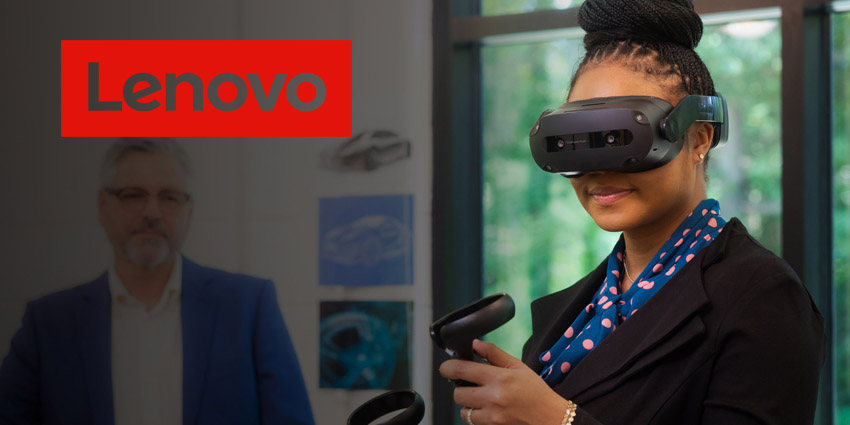Lenovo, the world’s largest PC manufacturer by unit sales, concluded its Tech World 2022 event on Tuesday, where it rallied several key executives and major partner firms to explore its latest updates.
The event gathered some of the world’s top tech firms such as Accenture, Qualcomm, IBM, AMD, VMware, Intel, DreamWorks, and others, to showcase Lenovo’s lastest tech solutions and concepts.
Ahead of the event, XR Today spoke to Jason McGuigan, Head of Commercial Virtual Reality (VR) for Lenovo, to discuss more on his company’s latest innovations, activities, and future plans.
Lenovo’s Latest Ventures
McGuigan began by stating Lenovo had an exciting week of events to attend and had received “a lot of input” from his previous announcement of the ThinkReality VRX at the Immerse Global Summit (IGS) 2022 Europe, which received positive feedback.
Lenovo had also advanced work with its partners, independent service vendors (ISVs), internal partners, and customer outreach, he told XR Today.
Elaborating, he said,
“We’ve gotten, just based on the initial announcements, a great amount of feedback that has been by and large fantastically positive, so we’re very excited about it”
Inspiration for Lenovo ThinkReality VRX
When asked by XR Today about Lenovo’s inspiration for creating the ThinkReality VRX, McGuigan explained how Lenovo’s longstanding history of working with immersive technologies led to several early devices.
Lenovo created headsets such as the Mirage Solo and Mirage VR S3, which used Google Daydream, as well as the Lenovo Explorer, a Microsoft Windows-based MR device, along with the company’s VR classroom platform.
Despite this, a “big gap in the market for enterprise training areas” remained, with solutions designed for training in verticals such as education and onboarding used “retrofitted consumer hardware” which “just wasn’t cutting it.”
He explained,
“To even sell to an enterprise or work appropriately with an enterprise IT department, you need to have something that’s validated, proven to be safe and secure, and have the right level of data privacy and in-road and connection to understanding how enterprises even work. That’s one of the areas that Lenovo has always specialised in, so we recognise that this gave us a very strong opportunity set in the market there”
Lenovo’s self-developed solution allowed its latest solutions to become “a true Lenovo full product,” namely to meet the criteria for its Think series of devices.
Product series such as the ThinkPad and ThinkStation produced “top-tier products within the enterprise,” he explained, citing widespread brand awareness and adoption from enterprises.
“Even inside Lenovo, it’s more difficult to be considered a finished product. For this to even be part of a ThinkReality, or event Think product, it gives it an even stronger standing within the product echelon within Lenovo, which is something we truly believe in”
ThinkReality VRX Specs Sheet
When asked about the specs of the ThinkReality VRX, Lenovo’s latest headset, McGuigan stated his company aimed to predict “the future to a degree” when developing its immersive technologies.
Many devices had a “relatively short lifecycle” due to the nature of the market, with most constantly “iterative and growing,” he said.
Rivals such as the Pico Neo and Meta Quest influenced the design of Lenovo’s headsets, but engineers targeted “the next generation of products” reshaping the industry’s future.
Lenovo also partnered with Qualcomm for its latest processor, the Snapdragon XR-2+, and shifted from Fresnal to Pancake lenses for greater visual clarity, performance, and smaller form factors.
It also includes a massive 6900 mAh battery with a balanced front-to-back headset form factor [with USB-C] and a high-resolution, full-colour passthrough for MR experiences and full interactivity.
Lenovo also partnered with Qualcomm to access their Snapdragon Spaces programme to integrate “very AR-like experiences.
Speaking further, McGuigan added,
“When we looked at this, we recognised we have to be top of the line with most of these things if we’re going to [offer clients] an expandable, versatile use. We have to really hit all those high marks and I believe we’ve achieved that”
According to data received from Lenovo, the ThinkReality VRX also has the following specifications:
- Android 12 Operating System (Android OS)
- 12 GB RAM and 128 GB storage
- 2280 x 2280 pixels per eye
- 95° Field Of Vision (FoV)
- 70/90Hz refresh rates
- 6 degrees of freedom (DoF) tracking with 4 cameras and hand-tracking controllers
- Integrated speakers with dual microphones and 3.5 mm headphone jack
- PC, WiFi, and USB-C streaming
- Wipeable materials
Enterprise Use Cases
When asked about potential use cases for the device, McGuigan cited industry applications such as Autodesk VRED and NVIDIA Cloud X for Architectural, Engineering, and Construction (AEC).
Devices processing “billions of polygons” with high-end graphics processing units (GPUs) now leveraged such platforms with standalone devices over the cloud, leading to immense versatility, he said.
Immersive tech focused on training and upskilling would influence future use cases for the device, as well as remote collaboration, which he referred to as the “flight simulators” for the workplace.
Learners with practical, hands-on experience with simulated learning tools were “much more effective to get people up and running” at a much higher degree, he said, adding,
McGuigan cited figures, showing,
“What we’re seeing is that things like soft skill training, you’d have up to four times faster training. Somebody that normally would take maybe an hour could take under 15 minutes [in VR]. Again, you have a [nearly] 300% jump in your confidence”
Verticals such as manufacturing, energy and nuclear power, medical, surgery, manufacturing, and others benefitted from the immersive training, he said, citing a major risk reduction in the workplace.
Workers at factories could learn “all the egress points, safety modalities, eyewashes,” and other key information at warehouses “on day one that may take them many weeks or months of being on the job [with traditional training],” he explained.
He concluded that immersive solutions could allow new hires to learn about facilities “before they even step foot” in them and interact remotely. Many organisations utilised MR for “onboarding and acclimating people to environments” before starting their professions.
Speaking further, McGuigan said,
“[If] we can give you that ability to feel comfortable at that facility on day one, we’ll make you better at your job, safer, and more effective overall. The metrics have proven that”
Full-Scale Solutions
Concluding, McGuigan told XR Today that Lenovo’s hardware and “full solution” ThinkReality mobile device management (MDM) allowed enterprises to remotely monitor their licencing and products.
Enterprises could select their ISPs along with Lenovo-certified ones for wider versatility of solutions, allowing companies to bundle them for streamlined financial models, he explained.
Speaking on the enterprise metaverse, the exec said,
“We’re trying to really push the idea of building towards this enterprise Metaverse, but making sure that it’s open. We have very strong identity of meeting the customer where they’re at. We’re not going to tell you how to develop with us, but say, ‘what are you most comfortable with, what works for your enterprise,’ and ‘let’s help you build around that'”
The firm also offered a full suite of services and onboarded a trove of ISV partners, including major partners such as ENGAGE XR and Talespin, to accommodate customers.
Concluding, McGuigan explained that newer, early-development devices were set for release later in the year and early 2023, with many already in “extremely high demand.”
The Lenovo Tech World 2022 took place on the 18th October and highlighted the enterprise’s future products and hybrid work, Metaverse, and MR solutions. It also revealed its sustainability pledges, rolling screen concepts, Motorola devices, and upcoming plans.







